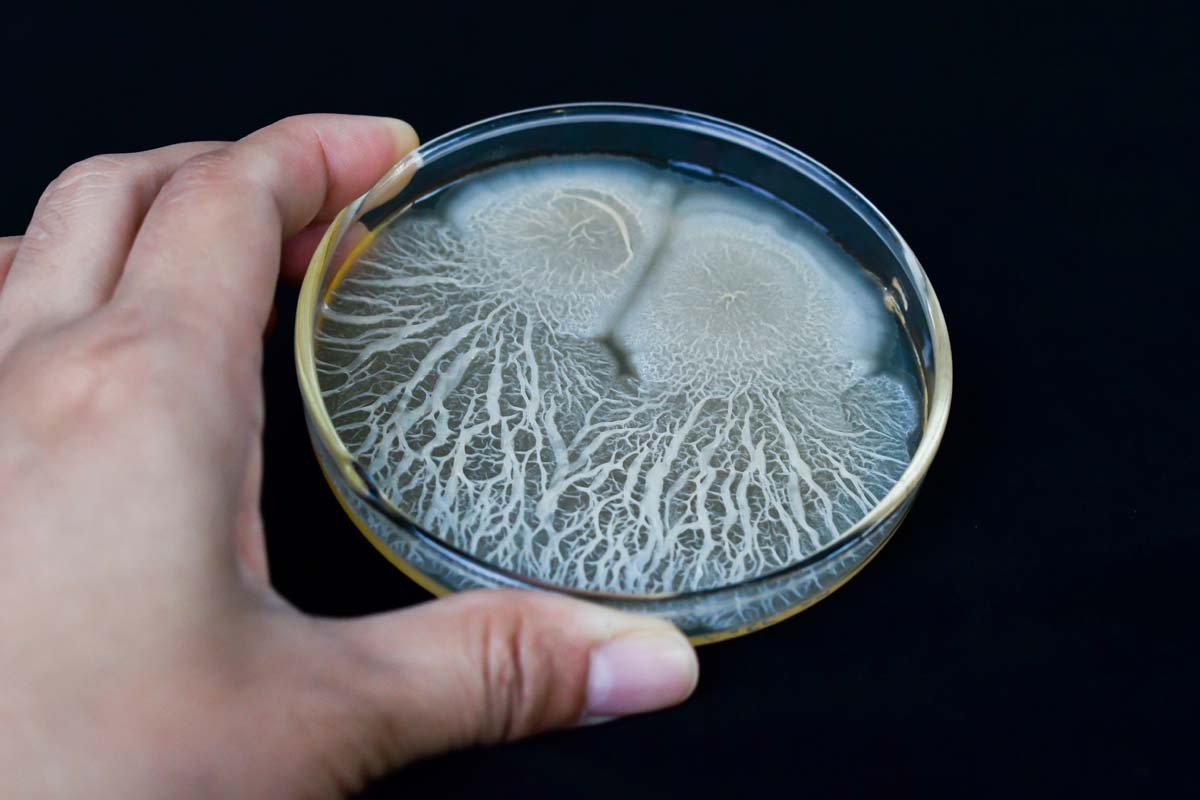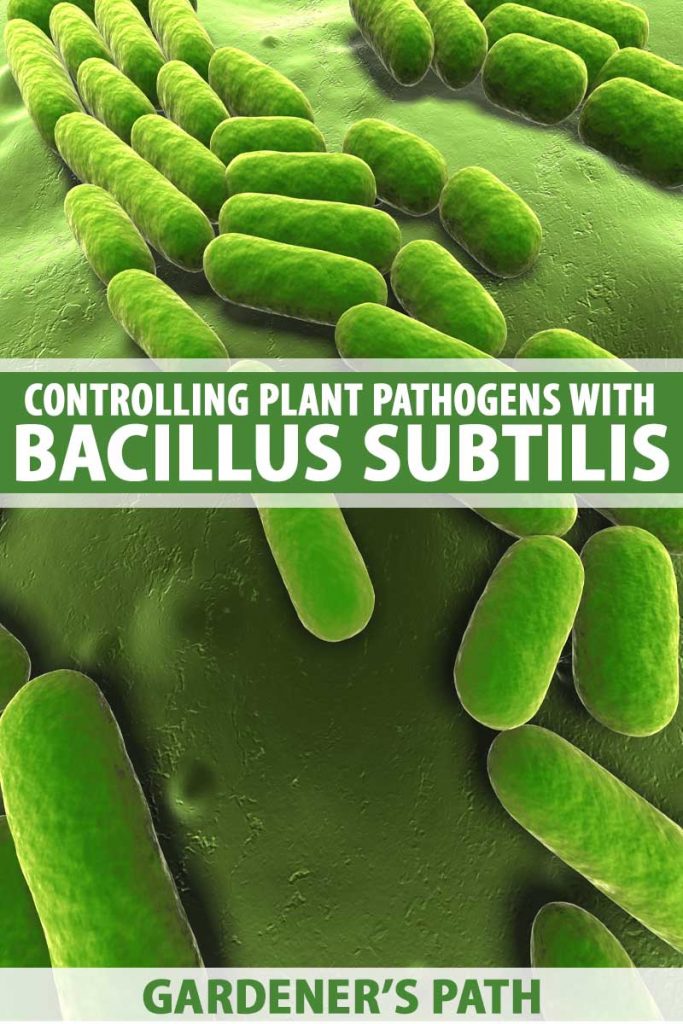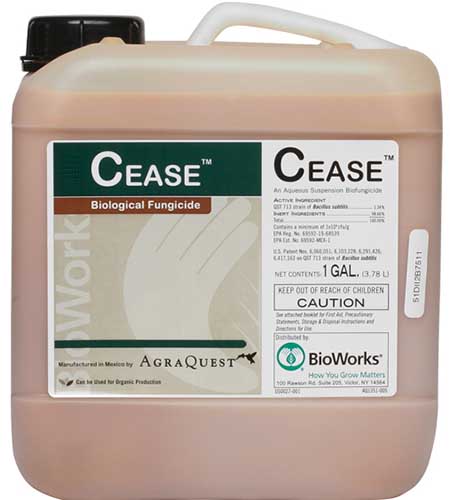[ad_1]
Bacillus subtilis is a species of bacteria that can survive in the soil for long periods. Many strains are highly effective at colonizing plant roots and controlling plant pathogens.
They can act directly against other microbes by producing a variety of antibiotics that affect fungi or bacteria. They can also act indirectly by stimulating the plant to activate its own defense mechanisms, so it can fend off attacking microbes.
This combination of activities results in a powerful biocontrol agent that is sold commercially to inhibit a number of pathogens on many different crops.


We link to vendors to help you find relevant products. If you buy from one of our links, we may earn a commission.
Even better – in addition to its biocontrol activities, B. subtilis helps the plants grow more effectively.
We at Gardener’s Path will explain how these bacteria work in detail and describe how to use them in your garden.
Bacillus Survives Harsh Conditions in the Soil
Many types of bacteria die out when the soil dries up and becomes unfavorable for their growth. In contrast, species of Bacillus produce spores that can survive for a long time and tolerate stressful conditions.
As soon as conditions improve, the spores germinate because of various environmental signals.
The ability of the bacteria to survive as spores makes it easier to produce formulations to use to treat plants. The bacteria are much more likely to survive for a long period when they are in the form of spores rather than as free-living bacteria.
After germination, the bacteria have specific sensors to guide them to plants, which they can then colonize. In addition to living on the roots, some strains of B. subtilis can also live within the plants and are known as endophytes.
Colonization of the Roots
The area in the soil right around roots can be a lush place for microbes. The roots secrete sugars and other compounds that microbes feed on. In exchange, these microbes help the plant by providing nutrients that would otherwise be in short supply.


This area is called the rhizosphere. Species of Bacillus commonly live on the plant roots and promote plant growth to such a degree that they are part of a group of bacteria known as plant growth promoting rhizobacteria (PGPR). These bacteria are so important that they have their own acronym!
The bacteria form what is called a biofilm on the plant roots. This is a whole community of bacteria embedded in a matrix comprised of chemicals from the bacterial cells.
The location of the bacteria in the rhizosphere gives them a competitive advantage when it comes to fending off plant pathogens.
Production of Antimicrobial Compounds
Strains of B. subtilis produce a variety of antibiotics and other compounds that inhibit other microbes. More than 24 types of different antibiotics have been reported to be produced by various strains.
These bacteria produce unusual types of antibiotics known as lipopeptides. You may recognize the term lipo as having to do with fat. These antibiotics interact with the fungal cell membranes (made up of lipids) and create holes in them, killing the fungi in the process.
There are several types of lipopeptides, with one important group being the iturins. They are “considered as an excellent biopesticide.”
Iturin Ahas been found to exhibit antifungal activity against a variety of fungi and shown to be involved in the control of several plant diseases.
Another group of antibiotics is the fencygins, which inhibit both bacteria and fungi.
These bacteria can even inhibit the germination of fungal spores!
Induction of Host Resistance
In addition to attacking other microbes, B. subtilis can help prevent disease by activating the plants to respond to pathogens.
Plants have an active immune system and frequently respond to microbial threats by ramping up their defenses to fend off viruses, bacteria, fungi, or nematodes.
They can respond in several different ways, but a common type is known as systemic acquired resistance or SAR. Systemic means that the resistance is active throughout the plant.
B. subtilis has been shown to activate this kind of resistance in many different crops and to inhibit pathogens in this manner.
Pathogens Controlled by Bacillus subtilis
These bacteria directly control soil-borne fungal pathogens like Rhizoctonia, Phytophthora, Fusarium, and Sclerotinia. The SAR that they induce in the plant can control foliar pathogens, such as the fungal pathogens powdery mildew, Botrytis, and Sclerotinia and the bacterial pathogens Erwinia and Xanthomonas.
Microbial Cooperation That Benefit Plants
You are probably familiar with mychorrhizae – the fungi that live on plant roots and help them absorb nutrients. B. subtilis acts synergistically with a particular kind of mycorrhizae – arbuscular mycorrhizal (AM) fungi.
By doing so, these organisms help the plants obtain nutrients like phosphorus that are often unavailable to plants. The soil can be full of phosphorus, but if it is not in a form that is easily taken up by the plants, they can become deficient in this nutrient.
This ability means that B. subtilis helps plants even when it is not helping to protect them from pathogens.
Individual Strains Have Different Properties
With biofungicides like B. subtilis, everything is strain dependent. Different strains make different combinations of chemicals and vary in their ability to colonize plant roots and inhibit other microbes.
So, you cannot expect to add different strains and have them act in identical manners.
The formulations also affect how well the microbes survive after application and protect the plants.
Your best bet is to purchase an established brand that is comprised of one strain that has been used in a variety of crops and soil types.
CEASE Biological Fungicide is a good option, and it is available from Arbico Organics.
How to Use Bacillus subtilis
You can use CEASE on plants ranging from vegetables and fruit trees to roses and houseplants.
CEASE Biological Fungicide (Bacillus subtilis) via ARBICO Organics
While this microbe isn’t toxic to people or animals, it is theoretically possible to develop allergies to some of the proteins if you are continually exposed to large amounts. Therefore, you should wear a dust/mist filtering respirator if you plan on applying large quantities of CEASE.
You should apply CEASE at the first sign of the development of disease on the leaves of your plants. Then apply it every seven days.
If there is a lot of disease, you can increase the frequency of spraying to three-day intervals. You should also spray more frequently if your plants are really moist.


You can spray in the direct sun or at high temperatures, but don’t use it if you expect irrigation or rain within four hours of application.
CEASE can be used with some pesticides, but you will have to check ahead of time to make sure they are compatible.
And if you are operating a large organic farm or one that practices good Integrated Pest Management (IPM) practices, Arbico Organics also has a variety of Bacillus subtilis in various strains, application methods, and sizes.
This Soil Organism Controls Both Root and Foliar Pathogens
Bacillus subtilis colonizes plant roots and attacks soil-borne pathogens directly. It also stimulates the plants to activate their natural resistance, which can act to control foliar pathogens.
The ability of these bacteria to form spores is a major reason for their success in the soil, since they can just go dormant if conditions are unfavorable.
Different strains vary in their properties, but CEASE is widely available commercially to control diseases on a broad array of plants.
Have you used Bacillus subtilis in your garden? If so, let us know how it worked in the comments.
And read on for information on other biofungicides:
[ad_2]
Source link


